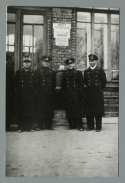Railway Post
The first railway opened in Estonia on 5th November (according to the old calendar on 24th October) in 1870 on the Paldiski-Tallinn-Narva-Gatchina line. In the same year, the new railway was connected with the Petersburg-Warsaw railway.
In 1877 Tapa-Tartu railway line was opened, which extended to Valga after ten years, where it was connected with the Pskov-Riga railway.
In 1896, the first narrow-gauge railway (750 mm) was established on the Valga-Pärnu railway line, and next year railway brunch from Mõisaküla to Viljandi, then continuing towards Paide and Tallinn's seaport. Traffic started to run between those two cities in 1901.
By 1904, there were established up to 650 km worth of broad-gauge railways and 373 km narrow-gauge railways - consequently Estonian territory transformed into one of the most densely built railway brunch areas in Tsarist Russia.
By the time of Estonian Independence, there were 92 railway stations and between 1918-1940 nearly 60 new stations were built.
The official post service at Baltic railway started on 7th November (26th October) 1870.
Post offices were opened in railways stations to improve the better run of postal service, at first in Tallinn (1870), Tartu and Tapa (1877), and in Valga (1889). With the year of 1915, there were 276 post offices in 80 different railway stations.
At the end of the Tsarist, there were 10 post wagons on five lines.
In the final years of Estonian independence, there were located 720 postal offices in 128 railway stations and served by railway officials.
Railway Post operated in Estonian from 1870 to 1998.
Mail transport at the Estonian railway ended in 1998, the last mail wagon was on the Tallinn-Narva line as a part of the Petersburg train. Railway history is long. The exhibition gives a brief glimpse from 1870 to 1940, also a couple of photos from the 1960s.
The exhibition is in two parts.
* * *
Whilst putting together the exhibition, the material was from the Estonian National Museum stamps history and private collections. Under the info button in the toolbar, you can access background information about mail history.
Enjoy!
The first railway opened in Estonia on 5th November (according to the old calendar on 24th October) in 1870 on the Paldiski-Tallinn-Narva-Gatchina line. In the same year, the new railway was connected with the Petersburg-Warsaw railway.
In 1877 Tapa-Tartu railway line was opened, which extended to Valga after ten years, where it was connected with the Pskov-Riga railway.
In 1896, the first narrow-gauge railway (750 mm) was established on the Valga-Pärnu railway line, and next year railway brunch from Mõisaküla to Viljandi, then continuing towards Paide and Tallinn's seaport. Traffic started to run between those two cities in 1901.
By 1904, there were established up to 650 km worth of broad-gauge railways and 373 km narrow-gauge railways - consequently Estonian territory transformed into one of the most densely built railway brunch areas in Tsarist Russia.
By the time of Estonian Independence, there were 92 railway stations and between 1918-1940 nearly 60 new stations were built.
The official post service at Baltic railway started on 7th November (26th October) 1870.
Post offices were opened in railways stations to improve the better run of postal service, at first in Tallinn (1870), Tartu and Tapa (1877), and in Valga (1889). With the year of 1915, there were 276 post offices in 80 different railway stations.
At the end of the Tsarist, there were 10 post wagons on five lines.
In the final years of Estonian independence, there were located 720 postal offices in 128 railway stations and served by railway officials.
Railway Post operated in Estonian from 1870 to 1998.
Mail transport at the Estonian railway ended in 1998, the last mail wagon was on the Tallinn-Narva line as a part of the Petersburg train. Railway history is long. The exhibition gives a brief glimpse from 1870 to 1940, also a couple of photos from the 1960s.
The exhibition is in two parts.
* * *
Whilst putting together the exhibition, the material was from the Estonian National Museum stamps history and private collections. Under the info button in the toolbar, you can access background information about mail history.
Enjoy!
















